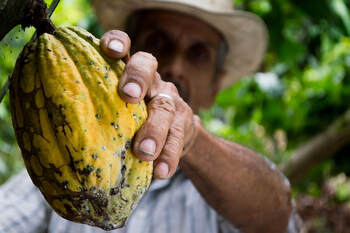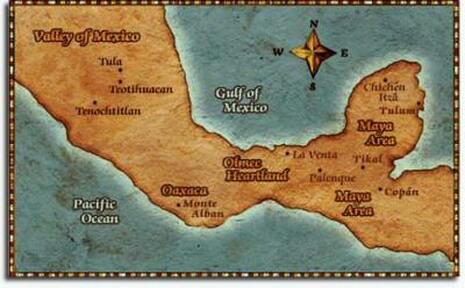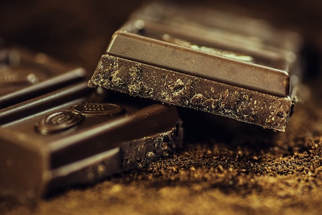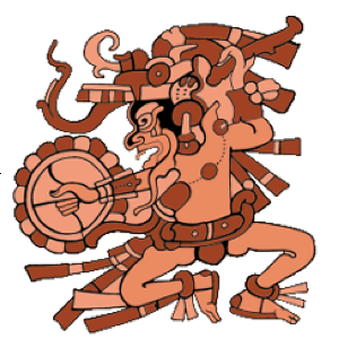Cocoa Butter
|
Theobroma cacao
|
A Brief History of Cocoa The story of chocolate begins with the ancient civilizations of Latin American. Cocoa flourished throughout the dense forests of Mexico and Central America (Belize, Costa Rica, El Salvador, Guatemala, Honduras, Nicaragua, and Panama), the same regions first settled by the Maya and Olmec civilizations.
|
Beginning around 2600 B.C.E., the Maya (or Mayans) built their settlements from Mexico to as far south in Central America as Honduras and Belize. Ruled by kings and priests, the Maya's greatest cities were not built until after 250 C.E. and through C.E. 900. The Olmecs were the next to come into existence, around 1400 B.C.E., and occupied some of the same territory as the Maya (1).
Adoption of Culture: The Maya and The Olmec
|
Although the relationship between the Maya and Olmec has never been well understood, we do know that the Maya would eventually adopt much of their culture from the Olmecs, including art, mathematics, astronomy, and hieroglyphics (1). It is also considered that the Olmecs were the first to discover cocoa, which then became popular amongst the Maya (2).
The first record of cocoa cultivation dates back to 1000 B.C.E. Then, the theobroma cacao (cocoa, chocolate) tree would have been found in abundance in the forests sprawled from the Gulf of Mexico to the Pacific ocean. Birds and animals would consume the meat and beans found in the fruit pods and disseminate them throughout the land in their travels. This allowed widespread growth of the chocolate tree, and provided an abundance of cacao for the civilizations in the area (2).
|
One of the oldest pieces of evidence found on chocolate consumption was discovered via cocoa residue inside a ceramic pot recovered from an excavation site in Rio Azul, Guatemala. The pot was dated back to the Pre-Classic period of Mesoamerican history which ranged from 2000 B.C.E. to 250 C.E. (2).
When we talk about chocolate, most of us think about it in the form of a bar. This way of making and eating chocolate did not develop until after cocoa was introduced to the west. For the civilizations of Mesoamerica, it was enjoyed as an unsweetened beverage. It was tradition to ferment the cocoa bean, followed by a thorough roasting before grinding it into powder. The powder was often mixed with dried corn or chilis and spices and eventually dissolved in water. After thorough mixing, the liquid would be poured from an exceptional height to encourage foaming, or frothing, upon impact from one container to the other (2).
When we talk about chocolate, most of us think about it in the form of a bar. This way of making and eating chocolate did not develop until after cocoa was introduced to the west. For the civilizations of Mesoamerica, it was enjoyed as an unsweetened beverage. It was tradition to ferment the cocoa bean, followed by a thorough roasting before grinding it into powder. The powder was often mixed with dried corn or chilis and spices and eventually dissolved in water. After thorough mixing, the liquid would be poured from an exceptional height to encourage foaming, or frothing, upon impact from one container to the other (2).
|
Ek ChuajMayan Hieroglyph |
|
In time, the cultivation of cocoa would become well developed by both the Aztecs and the Mayans. The cocoa bean itself was used as a form of currency and a unit of measurement, and cocoa production spread widely throughout Mesoamerica as people migrated the continent. Despite the popularity of cocoa, the beverage was often only a luxury for the upper class and soldiers. It would become a symbol of abundance and eventually find a place in religious ceremonies (6).
European and western cultures were not introduced to cocoa until much later by the Aztecs. Although first seen in 1502 by Christopher Columbus on a stop in Nicaragua, Columbus failed to appreciate the cocoa bean like Hernando Cortez would (6). |
“THESE SEEDS WHICH ARE CALLED ALMONDS OR CACAO ARE GROUND AND MADE INTO POWDER, AND OTHER SMALL SEEDS ARE GROUND, AND THIS POWDER IS PUT INTO CERTAIN BASINS WITH A POINT, AND THEN THEY PUT WATER ON IT AND MIX IT WITH A SPOON. AND AFTER HAVING MIXED IT WELL, THEY CHANGE IT FROM ONE BASIN TO ANOTHER, SO THAT A FOAM IS RAISED WHICH THEY PUT IN A VESSEL MADE FOR THE PURPOSE. AND WHEN THEY WISH TO DRINK IT, THEY MIX IT WITH CERTAIN SMALL SPOONS OF GOLD OR SILVER OR WOOD, AND DRINK IT, AND DRINKING IT ONE MUST OPEN ONE’S MOUTH, BECAUSE BEING FOAM ONE MUST GIVE IT ROOM TO SUBSIDE, AND GO DOWN BIT BY BIT. THIS DRINK IS THE HEALTHIEST THING, AND THE GREATEST SUSTENANCE OF ANYTHING YOU COULD DRINK IN THE WORLD, BECAUSE HE WHO DRINKS A CUP OF THIS LIQUID, NO MATTER HOW FAR HE WALKS, CAN GO A WHOLE DAY WITHOUT EATING ANYTHING ELSE.” |
After rallying his troops, burning his ships, and embarking on a journey to the Aztec capital of Tenochtitlan, it was then that Cortez was exposed to the cold cocoa beverage by the Emperor, Montezuma. Perhaps it was the stimulation of the caffeine in the cocoa or the reality that he had just sunk his entire fleet, but the chocolate-drink was a life-changing moment for Cortez. Many years later, with a compelling presentation centered on the idea of cocoa as a new trade item in Europe, Cortez successfully presented cocoa to the Spanish court. Soon after that cocoa was pressed into a bar and commercially produced. And the rest is history (2)(6).
"Of all the world’s agricultural commodities, cocoa – otherwise referred to as the ‘food of the gods’ – numbered among last year’s best-performing assets." – World Finance, 2016, (7)
Health Benefits of Cocoa
While research behind the health benefits of chocolate is only a few decades old, there is sufficient data available to talk about. Benefits range from chocolate consumption lowering blood pressure to providing stress relief and aid in weight loss. Don't give up on that bar of chocolate quite yet!
"There appears to be some scientific evidence to justify eating a moderate amount of dark chocolate daily." – Society of Environmental Toxicology and Chemistry, (8)
Antioxidants
Chocolate is rich in flavonoids, which are phytochemical compounds found in polyphenols. Polyphenols can be thought of as the chemicals that are synthesized from fruits, vegetables, chocolate, herbs, and so on, that provide those same food items with the benefits we more popularly know as antioxidants (8).
"Polyphenols are abundant micronutrients in our diet, and evidence for their role in the prevention of degenerative diseases such as cancer and cardiovascular diseases is emerging. The health effects of polyphenols depend on the amount consumed and on their bioavailability." - American Journal of Clinical Nutrition (9)
A Study was conducted to review the content of TAC (total antioxidant capacity, see study) found within fruits, vegetables, and other common foods. They tested foods that ranged from bananas, and chocolate, to apples, oranges, onions, etc. The food items that tested to have higher levels of TAC were Brazil nuts, guarana, coffee, and chocolate (10).
Conclusion:
Conclusion:
- Research supports that cocoa is high in antioxidants
Anti-infalmmatory
A review focused on understanding the antioxidant and anti-inflammatory properties of fruits and vegetables was completed by the Food Science Research Laboratories of Meiji. Co. Ltd, in Japan. Within their selection of fruits and vegetables was cacao and chocolate liquor (concentrated and fermented cacao) To understand these properties, specific flavonoids were reviewed:
"This review focuses on a specific group of (-)- epicatechins and their oligomers, the procyanidins, in cacao products. Dietary polyphenols in cacao products have been shown to reduce hypertension, reduce platelet aggregation, improve serum lipids, and lower the incidence of atherosclerosis in animal studies and clinical trials." Meiji. Co. Ltd, Food Science Research Laboratories (11)
Procyanidins are a particular class of flavonoids, found in higher concentrations of the flavonoids of the polyphenols in Theobroma cacao.
After studying the data, the research group decided that polyphenols were the antioxidant and anti-inflammatory mechanisms that reduce hypertension and atherosclerosis (11). Read the full review here.
Conclusion:
After studying the data, the research group decided that polyphenols were the antioxidant and anti-inflammatory mechanisms that reduce hypertension and atherosclerosis (11). Read the full review here.
Conclusion:
- There is sufficient evidence to support that cocoa can help reduce inflammation
Weight and Exercise
Diet and Satiation
It was once said that eating chocolate can help you lose weight. While the research to support that claim is not great, there is information to support that chocolate, specifically chocolate with higher cocoa content (i.e. dark chocolate), increases satiation, or the feeling of being full after eating (12).
The variety of chocolate that leads to weight gain will have more sugar, more fat, and contains less cocoa content. Learn about this and more under Health Risks (13).
Exercise and Weight Gain
If you are into supplements and nutrition, there may be a new product on the market you have heard about called epicatechin. Epicatechin is a flavonol or one of those plant-based phytochemicals we discussed earlier found in chocolate.
A study on epicatechin was performed at the Mexico School of Medicine at the University of California in San Diego. Specifically, the goal was to understand epicatechin's relationship with protein and muscle building as a possible tool to help fight Muscular dystrophies (MDs) (14).
Using mice as the test subjects, the group found a positive relationship between epicatechin and reduced oxidative stress on the body, as well as increased protein levels:
It was once said that eating chocolate can help you lose weight. While the research to support that claim is not great, there is information to support that chocolate, specifically chocolate with higher cocoa content (i.e. dark chocolate), increases satiation, or the feeling of being full after eating (12).
The variety of chocolate that leads to weight gain will have more sugar, more fat, and contains less cocoa content. Learn about this and more under Health Risks (13).
Exercise and Weight Gain
If you are into supplements and nutrition, there may be a new product on the market you have heard about called epicatechin. Epicatechin is a flavonol or one of those plant-based phytochemicals we discussed earlier found in chocolate.
A study on epicatechin was performed at the Mexico School of Medicine at the University of California in San Diego. Specifically, the goal was to understand epicatechin's relationship with protein and muscle building as a possible tool to help fight Muscular dystrophies (MDs) (14).
Using mice as the test subjects, the group found a positive relationship between epicatechin and reduced oxidative stress on the body, as well as increased protein levels:
"Increases in the protein levels of thioredoxin, glutathione peroxidase, superoxide dismutase 2, catalase, and mitochondrial endpoints. Furthermore, we found decreases in heart and skeletal muscle fibrosis, accompanied by an improvement in skeletal muscle function, with treatment." (14)
Conclusion:
- There is evidence to support that cocoa can help reduce appetite and help increase proteins in the body necessary for muscle development
Brain Health
Brain Protection
A growing public health concern is cognitive impairment and cognitive decline - or brain disease, such as Alzheimer's dementia. Research shows that eating the right kind of chocolate may help increase blood flow to the brain, providing protection against the mental illnesses that come with old age (15) (16) (17).
A growing public health concern is cognitive impairment and cognitive decline - or brain disease, such as Alzheimer's dementia. Research shows that eating the right kind of chocolate may help increase blood flow to the brain, providing protection against the mental illnesses that come with old age (15) (16) (17).
"As it emerges from this systematic review, the use of some phytochemicals and botanicals seems to be very promising in order to delay the onset and progression of neurodegenerative and other age-related diseases" - Department of Medical and Surgical Sciences, Alma Mater Studiorum University of Bologna, Italy (17)
One study, in particular, found that brachial and cerebrovascular functions are enhanced in postmenopausal women after eating chocolate containing high concentrations of cocoa.
Conclusion:
Conclusion:
- There is growing evidence to support that eating dark chocolate can improve brain-health and prevent brain disease.
How Cocoa Benefits the Skin
Antioxidants, of course! By now we know that cacao contains a lot of polyphenols. We also know that polyphenols are abundant micronutrients found in our food. So it should come as no surprise that when we apply cocoa to our skin we are allowing those polyphenols to be absorbed directly by our body's largest organ (19).
Conclusion:
Conclusion:
- Cacao butter is great for moisturizing and repairing the skin.
Health Risks of Cocoa
In moderation, chocolate is moderately healthy. There are a few risks to be aware of, of course.
Over-consumption
The reason why chocolate has developed a bad name as an unhealthy food is that it is usually made with high amounts of sugar and fat. In addition, the cocoa concentrations are typically below the level recommended to receive antioxidants. Ultimately, unless you are eating cocoa raw, making it yourself with less sugar and fat, or have found a healthy brand, eat your chocolate in moderation!
Allergies
You may be allergic to chocolate! Be careful when eating it for the first time.
Pregnancy
You may have heard at one point that chocolate was dangerous to eat or use on the skin if you are pregnant. As reviewed in March, 2018 by a Department of Physiology in Saudi Arabia:
Over-consumption
The reason why chocolate has developed a bad name as an unhealthy food is that it is usually made with high amounts of sugar and fat. In addition, the cocoa concentrations are typically below the level recommended to receive antioxidants. Ultimately, unless you are eating cocoa raw, making it yourself with less sugar and fat, or have found a healthy brand, eat your chocolate in moderation!
Allergies
You may be allergic to chocolate! Be careful when eating it for the first time.
Pregnancy
You may have heard at one point that chocolate was dangerous to eat or use on the skin if you are pregnant. As reviewed in March, 2018 by a Department of Physiology in Saudi Arabia:
"The purpose of this review is to explore the effects of chocolate consumption during pregnancy on fetus and mother herself...... Chocolate is nonteratogenic and does not affect reproductive indices.
Metabolic derangements in offsprings born to chocolate fed dams have been reported. Pregnant females must be careful about consumption of cocoa and chocolate. Future studies should be planned".
- Department of Physiology, College of Medicine , Imam Abdulrahman Bin Faisal University , Dammam , Saudi Arabia (20)
Conclusion:
- Eat healthy chocolate, watch for allergic reactions, and if you are pregnant, well, what do you think? Leave a Comment below.
Works Cited:
1) The Difference Between The Aztec, Maya, Inca, And Olmec. http://knowledgenuts.com/2013/10/22/the-difference-between-the-aztec-maya-inca-and-olmec/
2) A Brief History of Cocoa. http://www.medicinehunter.com/brief-history-cocoa
3) Xibalba (shee-BAHL-bah). http://www.xibalbacacao.com/about.htm
4) The legend behind chocolate. http://www.vallartafactory.com/en/chocolate-origins-vallarta-chocolate-factory/
5) Mayan Goddess Ixcacao Goddess of Chocolate. http://www.goddessgift.com/goddess-myths/Mayan-goddess-chocolate.html
6) HISTORY OF COCOA. http://www.worldagroforestry.org/treesandmarkets/inaforesta/history.htm
7) Chocolate’s dark side as a global commodity. World Finance. https://www.worldfinance.com/markets/chocolates-dark-side-as-a-global-commodity
8) Overview of scientific evidence for chocolate health benefits. SETAC. https://setac.onlinelibrary.wiley.com/doi/10.1002/ieam.1594/fullhttps://www.ncbi.nlm.nih.gov/pubmed/24915376
9) Polyphenols: food sources and bioavailability. The American Journal of Clinical Nutrition. https://academic.oup.com/ajcn/article/79/5/727/4690182v
10) An apple plus a Brazil nut a day keeps the doctors away: antioxidant capacity of foods and their health benefits. https://www.ncbi.nlm.nih.gov/pubmed/26572874
11) Polyphenols: Inflamation. https://www.ncbi.nlm.nih.gov/pubmed/29119920.
12) Consumption of dark chocolate attenuates subsequent food intake compared with milk and white chocolate in postmenopausal women. https://www.ncbi.nlm.nih.gov/pubmed/28572069
13) Does cocoa/dark chocolate supplementation have favorable effect on body weight, body mass index and waist circumference? A systematic review, meta-analysis and dose-response of randomized clinical trials. https://www.ncbi.nlm.nih.gov/pubmed/29553824
14) (-)-Epicatechin improves mitochondrial-related protein levels and ameliorates oxidative stress in dystrophic δ-sarcoglycan null mouse striated muscle. https://www.ncbi.nlm.nih.gov/pubmed/25284161
15) Brain Protection and Cognitive Function: Cocoa Flavonoids as Nutraceuticals. https://www.ncbi.nlm.nih.gov/pubmed/26561075
16) Acute cocoa flavanol improves cerebral oxygenation without enhancing executive function at rest or after exercise. https://www.ncbi.nlm.nih.gov/pubmed/27849355
17) Botanicals and phytochemicals active on cognitive decline: The clinical evidence. https://www.ncbi.nlm.nih.gov/pubmed/29289576
18) Brachial and Cerebrovascular Functions Are Enhanced in Postmenopausal Women after Ingestion of Chocolate with a High Concentration of Cocoa. https://www.ncbi.nlm.nih.gov/pubmed/28794213
19) Cocoa polyphenols and their influence on parameters involved in ex vivo skin restructuring. https://www.ncbi.nlm.nih.gov/pubmed/18822039
20) Maternal and fetal effects of chocolate consumption during pregnancy: a systematic review. https://www.ncbi.nlm.nih.gov/pubmed/29534636
2) A Brief History of Cocoa. http://www.medicinehunter.com/brief-history-cocoa
3) Xibalba (shee-BAHL-bah). http://www.xibalbacacao.com/about.htm
4) The legend behind chocolate. http://www.vallartafactory.com/en/chocolate-origins-vallarta-chocolate-factory/
5) Mayan Goddess Ixcacao Goddess of Chocolate. http://www.goddessgift.com/goddess-myths/Mayan-goddess-chocolate.html
6) HISTORY OF COCOA. http://www.worldagroforestry.org/treesandmarkets/inaforesta/history.htm
7) Chocolate’s dark side as a global commodity. World Finance. https://www.worldfinance.com/markets/chocolates-dark-side-as-a-global-commodity
8) Overview of scientific evidence for chocolate health benefits. SETAC. https://setac.onlinelibrary.wiley.com/doi/10.1002/ieam.1594/fullhttps://www.ncbi.nlm.nih.gov/pubmed/24915376
9) Polyphenols: food sources and bioavailability. The American Journal of Clinical Nutrition. https://academic.oup.com/ajcn/article/79/5/727/4690182v
10) An apple plus a Brazil nut a day keeps the doctors away: antioxidant capacity of foods and their health benefits. https://www.ncbi.nlm.nih.gov/pubmed/26572874
11) Polyphenols: Inflamation. https://www.ncbi.nlm.nih.gov/pubmed/29119920.
12) Consumption of dark chocolate attenuates subsequent food intake compared with milk and white chocolate in postmenopausal women. https://www.ncbi.nlm.nih.gov/pubmed/28572069
13) Does cocoa/dark chocolate supplementation have favorable effect on body weight, body mass index and waist circumference? A systematic review, meta-analysis and dose-response of randomized clinical trials. https://www.ncbi.nlm.nih.gov/pubmed/29553824
14) (-)-Epicatechin improves mitochondrial-related protein levels and ameliorates oxidative stress in dystrophic δ-sarcoglycan null mouse striated muscle. https://www.ncbi.nlm.nih.gov/pubmed/25284161
15) Brain Protection and Cognitive Function: Cocoa Flavonoids as Nutraceuticals. https://www.ncbi.nlm.nih.gov/pubmed/26561075
16) Acute cocoa flavanol improves cerebral oxygenation without enhancing executive function at rest or after exercise. https://www.ncbi.nlm.nih.gov/pubmed/27849355
17) Botanicals and phytochemicals active on cognitive decline: The clinical evidence. https://www.ncbi.nlm.nih.gov/pubmed/29289576
18) Brachial and Cerebrovascular Functions Are Enhanced in Postmenopausal Women after Ingestion of Chocolate with a High Concentration of Cocoa. https://www.ncbi.nlm.nih.gov/pubmed/28794213
19) Cocoa polyphenols and their influence on parameters involved in ex vivo skin restructuring. https://www.ncbi.nlm.nih.gov/pubmed/18822039
20) Maternal and fetal effects of chocolate consumption during pregnancy: a systematic review. https://www.ncbi.nlm.nih.gov/pubmed/29534636






